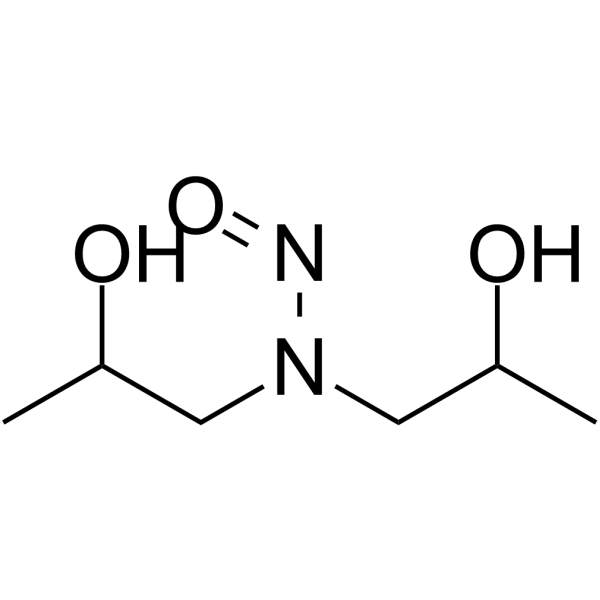
N-Bis(2-hydroxypropyl)nitrosamine
CAS No. 53609-64-6
N-Bis(2-hydroxypropyl)nitrosamine( DHPN | Di(2-hydroxypropyl)nitrosamine | Diisopropanolnitrosamine )
Catalog No. M27093 CAS No. 53609-64-6
N-Bis(2-hydroxypropyl)nitrosamine is a carcinogenic agent.
Purity : >98% (HPLC)
 COA
COA
 Datasheet
Datasheet
 HNMR
HNMR
 HPLC
HPLC
 MSDS
MSDS
 Handing Instructions
Handing Instructions
| Size | Price / USD | Stock | Quantity |
| 10MG | 35 | Get Quote |


|
| 25MG | 72 | Get Quote |


|
| 50MG | 87 | Get Quote |


|
| 100MG | 140 | Get Quote |


|
| 200MG | 237 | Get Quote |


|
| 500MG | 395 | Get Quote |


|
| 1G | Get Quote | Get Quote |


|
Biological Information
-
Product NameN-Bis(2-hydroxypropyl)nitrosamine
-
NoteResearch use only, not for human use.
-
Brief DescriptionN-Bis(2-hydroxypropyl)nitrosamine is a carcinogenic agent.
-
DescriptionN-Bis(2-hydroxypropyl)nitrosamine is a carcinogenic agent.(In Vivo):The carcinogenic activity of orally administered N-bis(2-hydroxypropyl)-nitrosamine (DHPN) in male Wistar rats was evaluated with respect to its dose. DHPN was administered at two doses, 100 ppm and 500 ppm, in the drinking water to rats for 25 to 52 weeks. Tumors developed in the lung, liver, and thyroid of rats receiving 100 ppm DHPN and in the lung, liver thyroid, esophagus, kidney, and urinary bladder of rats receiving 500 ppm DHPN. The principal target organ was the lung in rats receiving either 100 or 500 ppm DHPN, indicating that the carcinogenic action of these doses of DHPN was similar to that of higher doses previously reported.
-
In VitroN-Bis(2-hydroxypropyl)nitrosamine is an agent with carcinogenic activity.
-
In VivoN-Bis(2-hydroxypropyl)nitrosamine causes the tumors to develop in the lung, liver, and thyroid of rats at a dose of 100 ppm, in the lung, liver thyroid, esophagus, kidney, and urinary bladder of rats at a dose of 500 ppm, and in the lung, liver thyroid, esophagus, kidney, and urinary bladder of rats at both doses. Bisphenol A (BPA) enhances the susceptibility to thyroid carcinoma stimulated by N-Bis(2-hydroxypropyl)nitrosamine (DHPN; 2800 mg/kg) in rats.
-
SynonymsDHPN | Di(2-hydroxypropyl)nitrosamine | Diisopropanolnitrosamine
-
PathwayOthers
-
TargetOther Targets
-
RecptorDNA synthesis
-
Research Area——
-
Indication——
Chemical Information
-
CAS Number53609-64-6
-
Formula Weight162.189
-
Molecular FormulaC6H14N2O3
-
Purity>98% (HPLC)
-
SolubilityIn Vitro:?DMSO : ≥ 125 mg/mL (770.70 mM)
-
SMILESCC(O)CN(CC(C)O)N=O
-
Chemical Name——
Shipping & Storage Information
-
Storage(-20℃)
-
ShippingWith Ice Pack
-
Stability≥ 2 years
Reference
1.Whitley RJ, et al. Sorivudine: a?potent?inhibitor?of?varicella?zoster?virus?replication.Adv Exp Med Biol.?1996;394:41-4.
molnova catalog



related products
-
JNJ-31020028
JNJ-31020028 is a selective brain penetrant antagonist of neuropeptide Y2 receptor with high affinity(pIC50=8.07, human; pIC50=8.22 rat).
-
Fibronectin Adhesion...
Fibronectin Adhesion-promoting Peptide (Heparin Binding Peptide) is one of the heparin-binding amino acid sequences found in the carboxy-terminal heparin-binding domain of fibronectin.
-
HPPE
HPPE is a selective inhibitor of Bach1 that acts non-electrophilically. HPPE targets the heme-binding sites on the Bach1 protein and leads to the alleviation of Bach1-mediated repression.



 Cart
Cart
 sales@molnova.com
sales@molnova.com


